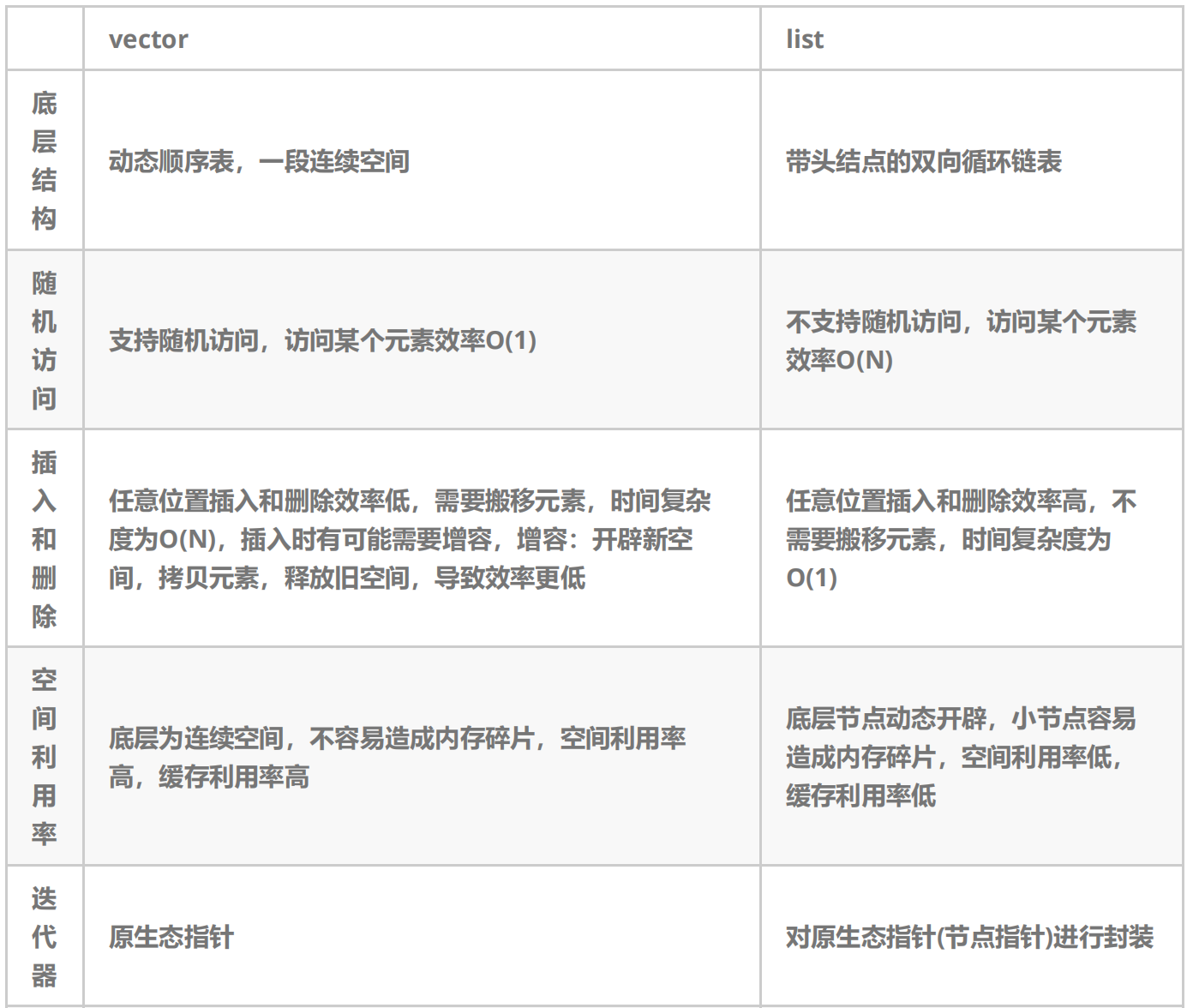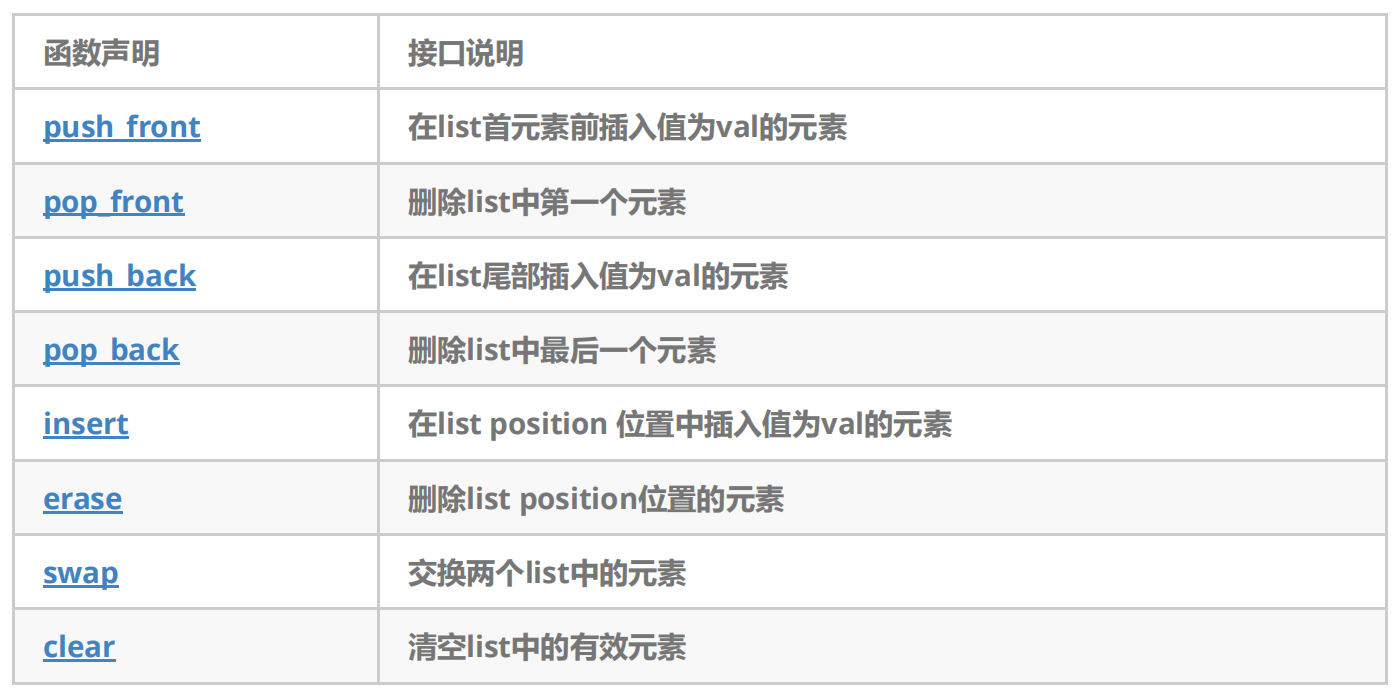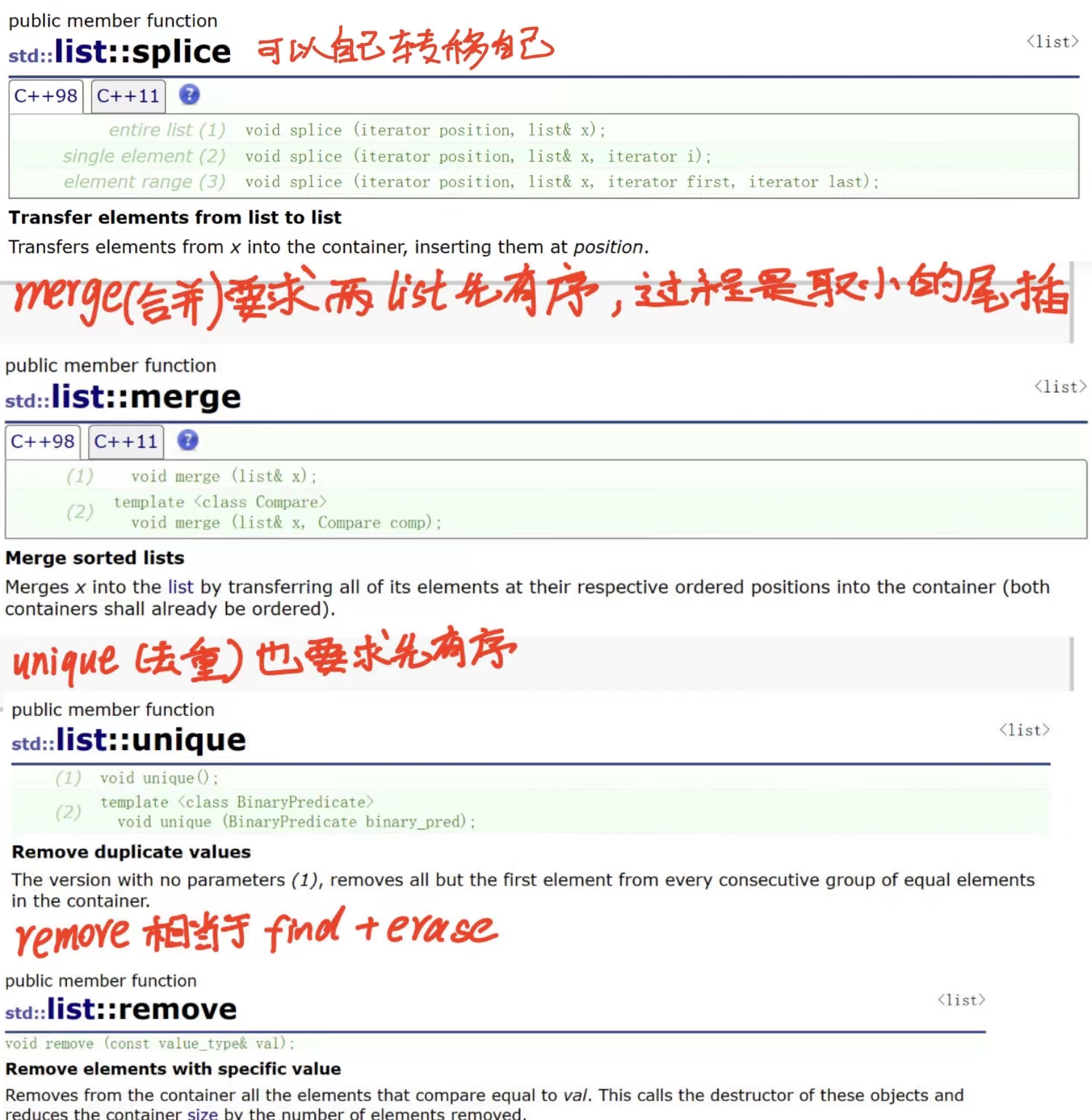list
一.list的介绍及使用
1. list的介绍
- list是可以在常数范围内在任意位置进行插入和删除的序列式容器,并且该容器可以前后双向迭代。
- list的底层是双向链表结构,双向链表中每个元素存储在互不相关的独立节点中,在节点中通过指针指向其前一个元素和后一个元素。
- list与forward_list非常相似:最主要的不同在于forward_list是单链表,只能朝前迭代,已让其更简单高效。
- 与其他的序列式容器相比(array,vector,deque),list通常在任意位置进行插入、移除元素的执行效率更好。
- 与其他序列式容器相比,list和forward_list最大的缺陷是不支持任意位置的随机访问,比如:要访问list的第6个元素,必须从已知的位置(比如头部或者尾部)迭代到该位置,在这段位置上迭代需要线性的时间开销;list还需要一些额外的空间,以保存每个节点的相关联信息(对于存储类型较小元素的大list来说这可能是一个重要的因素)

2. list的使用
list中的接口比较多,此处类似,只需要掌握如何正确的使用,然后再去深入研究背后的原理,已达到可扩展的能力。以下为list中一些常见的重要接口。
(1).list的构造
(2). list iterator的使用
此处,大家可暂时将迭代器理解成一个指针,该指针指向list中的某个节点。
【注意】
- begin与end为正向迭代器,对迭代器执行++操作,迭代器向后移动
- rbegin(end)与rend(begin)为反向迭代器,对迭代器执行++操作,迭代器向前移动
(3).list capacity
(4). list element access
(5).list modifiers
补充:
list的resize就是一个尾插, 尾删.
list的插入和删除使用代码演示
list中还有一些操作,需要用到时大家可参阅list的文档说明。
(6). list的迭代器失效
前面说过,此处大家可将迭代器暂时理解成类似于指针,迭代器失效即迭代器所指向的节点的无效,即该节点被删除了。因为list的底层结构为带头结点的双向循环链表,因此在list中进行插入时是不会导致list的迭代器失效的,只有在删除时才会失效,并且失效的只是指向被删除节点的迭代器,其他迭代器不会受到影响。
void TestListIterator1()
{
int array[] = { 1, 2, 3, 4, 5, 6, 7, 8, 9, 0 };
list<int> l(array, array + sizeof(array) / sizeof(array[0]));
auto it = l.begin();
while (it != l.end())
{
// erase()函数执行后,it所指向的节点已被删除,因此it无效,在下一次使用it时,必须先给
其赋值
l.erase(it);
++it;
}
}
// 改正
void TestListIterator()
{
int array[] = { 1, 2, 3, 4, 5, 6, 7, 8, 9, 0 };
list<int> l(array, array + sizeof(array) / sizeof(array[0]));
auto it = l.begin();
while (it != l.end())
{
l.erase(it++); // it = l.erase(it);
}
}
二.list的模拟实现
1. 模拟实现list
要模拟实现list,必须要熟悉list的底层结构以及其接口的含义,通过上面的学习,这些内容已基本掌握,现在我们来模拟实现list。
#pragma once
#include<iostream>
#include<assert.h>
#include<algorithm>
using std::cout;
using std::endl;
namespace bit
{
template<class T>
struct ListNode
{
ListNode* _next;
ListNode* _prev;
T _data;
ListNode(const T& x=T())
:_next(nullptr)
,_prev(nullptr)
,_data(x)
{}
};
//法二:增加两个模板参数(编译器实例化生成了两个类)
template<class T,class Ref,class Ptr>
struct ListIterator
{
typedef ListNode<T> Node;
typedef ListIterator<T, Ref, Ptr> Self;
Node* _node;
ListIterator(Node* node)
:_node(node)
{}
// *it
//T& operator*()
Ref operator*()
{
return _node->_data;
}
//T* operator->()
Ptr operator->()
{
return &(_node->_data);
}
// ++it
Self& operator ++()
{
_node = _node->_next;
return *this;
}
// it++
Self operator ++(int)
{
Self tmp(*this);//浅拷贝不需要写拷贝构造
_node = _node->_next;
return tmp;
}
Self& operator --()
{
_node = _node->_prev;
return *this;
}
Self operator --(int)
{
Self tmp(*this);//浅拷贝不需要写拷贝构造
_node = _node->_prev;
return tmp;
}
bool operator!=(const Self& it)
{
return _node != it._node;
}
bool operator ==(const Self& it)
{
return _node == it._node;
}
};
//法一:写两个类
//template<class T>
//struct ListConstIterator
//{
// typedef ListNode<T> Node;
// typedef ListConstIterator<T> Self;
// Node* _node;
// ListConstIterator(Node* node)
// :_node(node)
// {}
// // *it
// const T& operator*()
// {
// return _node->_data;
// }
// const T* operator->()
// {
// return &(_node->_data);
// }
// // ++it
// Self& operator ++()
// {
// _node = _node->_next;
// return *this;
// }
// // it++
// Self operator ++(int)
// {
// Self tmp(*this);//浅拷贝不需要写拷贝构造
// _node = _node->_next;
// return tmp;
// }
// Self& operator --()
// {
// _node = _node->_prev;
// return *this;
// }
// Self operator --(int)
// {
// Self tmp(*this);//浅拷贝不需要写拷贝构造
// _node = _node->_prev;
// return tmp;
// }
// bool operator!=(const Self& it)
// {
// return _node != it._node;
// }
// bool operator ==(const Self& it)
// {
// return _node == it._node;
// }
//};
template<class T>
class list
{
typedef ListNode<T> Node;
public:
//法一的typedef
//typedef ListIterator<T> iterator;
//typedef ListConstIterator<T> const_iterator;
//法二的typedef
typedef ListIterator<T,T&,T*> iterator;
typedef ListIterator<T,const T&,const T*> const_iterator;
iterator begin()
{
return iterator(_head->_next);
//可以直接写return _head->_next;
//单参数构造函数可以隐式类型转换
}
iterator end()
{
return iterator(_head);
}
const_iterator begin()const
{
return const_iterator(_head->_next);
}
const_iterator end()const
{
return const_iterator(_head);
}
void empty_init()
{
_head = new Node;
_head->_next = _head;
_head->_prev = _head;
_size = 0;
}
list()
{
empty_init();
}
list(const list<T>& lt)
{
empty_init();
for (auto& e : lt)
{
push_back(e);
}
}
void swap(list<T>& lt)
{
std::swap(_head, lt._head);
std::swap(_size, lt._size);
}
list<T>& operator=(list<T> lt)
{
swap(lt);
return *this;
}
void clear()
{
iterator it = begin();
while (it != end())
{
it = erase(it);
it++;
}
}
~list()
{
clear();
delete _head;
_head = nullptr;
}
/*void push_back(const T& x)
{
Node* newnode = new Node;
Node* tail = _head->_prev;
newnode->_data = x;
tail->_next = newnode;
newnode->_prev = tail;
newnode->_next = _head;
_head->_prev = newnode;
}*/
void push_back(const T& x)
{
insert(end(), x);
}
void push_front(const T& x)
{
insert(begin(), x);
}
void pop_back()
{
erase(--end());
}
void pop_front()
{
erase(begin());
}
void insert(iterator pos,const T& val)
{
Node* cur = pos._node;
Node* newnode = new Node(val);
Node* prev = cur->_prev;
//prev newnode cur
prev->_next = newnode;
newnode->_prev = prev;
newnode->_next = cur;
cur->_prev = newnode;
_size++;
}
iterator erase(iterator pos)
{
Node* cur = pos._node;
Node* prev = cur->_prev;
Node* next = cur->_next;
prev->_next = next;
next->_prev = prev;
delete cur;
_size--;
return iterator(next);
}
size_t size()const
{
return _size;
}
bool empty()const
{
return _size==0;
}
private:
Node* _head;
size_t _size=0;
};
}
2. list与vector的对比
vector与list都是STL中非常重要的序列式容器,由于两个容器的底层结构不同,导致其特性以及应用场景不同,其主要不同如下:


list
一.list的介绍及使用
1. list的介绍
- list是可以在常数范围内在任意位置进行插入和删除的序列式容器,并且该容器可以前后双向迭代。
- list的底层是双向链表结构,双向链表中每个元素存储在互不相关的独立节点中,在节点中通过指针指向其前一个元素和后一个元素。
- list与forward_list非常相似:最主要的不同在于forward_list是单链表,只能朝前迭代,已让其更简单高效。
- 与其他的序列式容器相比(array,vector,deque),list通常在任意位置进行插入、移除元素的执行效率更好。
- 与其他序列式容器相比,list和forward_list最大的缺陷是不支持任意位置的随机访问,比如:要访问list的第6个元素,必须从已知的位置(比如头部或者尾部)迭代到该位置,在这段位置上迭代需要线性的时间开销;list还需要一些额外的空间,以保存每个节点的相关联信息(对于存储类型较小元素的大list来说这可能是一个重要的因素)

2. list的使用
list中的接口比较多,此处类似,只需要掌握如何正确的使用,然后再去深入研究背后的原理,已达到可扩展的能力。以下为list中一些常见的重要接口。
(1).list的构造
(2). list iterator的使用
此处,大家可暂时将迭代器理解成一个指针,该指针指向list中的某个节点。
【注意】
- begin与end为正向迭代器,对迭代器执行++操作,迭代器向后移动
- rbegin(end)与rend(begin)为反向迭代器,对迭代器执行++操作,迭代器向前移动
(3).list capacity
(4). list element access
(5).list modifiers
补充:
list的resize就是一个尾插, 尾删.
list的插入和删除使用代码演示
list中还有一些操作,需要用到时大家可参阅list的文档说明。
(6). list的迭代器失效
前面说过,此处大家可将迭代器暂时理解成类似于指针,迭代器失效即迭代器所指向的节点的无效,即该节点被删除了。因为list的底层结构为带头结点的双向循环链表,因此在list中进行插入时是不会导致list的迭代器失效的,只有在删除时才会失效,并且失效的只是指向被删除节点的迭代器,其他迭代器不会受到影响。
void TestListIterator1()
{
int array[] = { 1, 2, 3, 4, 5, 6, 7, 8, 9, 0 };
list<int> l(array, array + sizeof(array) / sizeof(array[0]));
auto it = l.begin();
while (it != l.end())
{
// erase()函数执行后,it所指向的节点已被删除,因此it无效,在下一次使用it时,必须先给
其赋值
l.erase(it);
++it;
}
}
// 改正
void TestListIterator()
{
int array[] = { 1, 2, 3, 4, 5, 6, 7, 8, 9, 0 };
list<int> l(array, array + sizeof(array) / sizeof(array[0]));
auto it = l.begin();
while (it != l.end())
{
l.erase(it++); // it = l.erase(it);
}
}
二.list的模拟实现
1. 模拟实现list
要模拟实现list,必须要熟悉list的底层结构以及其接口的含义,通过上面的学习,这些内容已基本掌握,现在我们来模拟实现list。
#pragma once
#include<iostream>
#include<assert.h>
#include<algorithm>
using std::cout;
using std::endl;
namespace bit
{
template<class T>
struct ListNode
{
ListNode* _next;
ListNode* _prev;
T _data;
ListNode(const T& x=T())
:_next(nullptr)
,_prev(nullptr)
,_data(x)
{}
};
//法二:增加两个模板参数(编译器实例化生成了两个类)
template<class T,class Ref,class Ptr>
struct ListIterator
{
typedef ListNode<T> Node;
typedef ListIterator<T, Ref, Ptr> Self;
Node* _node;
ListIterator(Node* node)
:_node(node)
{}
// *it
//T& operator*()
Ref operator*()
{
return _node->_data;
}
//T* operator->()
Ptr operator->()
{
return &(_node->_data);
}
// ++it
Self& operator ++()
{
_node = _node->_next;
return *this;
}
// it++
Self operator ++(int)
{
Self tmp(*this);//浅拷贝不需要写拷贝构造
_node = _node->_next;
return tmp;
}
Self& operator --()
{
_node = _node->_prev;
return *this;
}
Self operator --(int)
{
Self tmp(*this);//浅拷贝不需要写拷贝构造
_node = _node->_prev;
return tmp;
}
bool operator!=(const Self& it)
{
return _node != it._node;
}
bool operator ==(const Self& it)
{
return _node == it._node;
}
};
//法一:写两个类
//template<class T>
//struct ListConstIterator
//{
// typedef ListNode<T> Node;
// typedef ListConstIterator<T> Self;
// Node* _node;
// ListConstIterator(Node* node)
// :_node(node)
// {}
// // *it
// const T& operator*()
// {
// return _node->_data;
// }
// const T* operator->()
// {
// return &(_node->_data);
// }
// // ++it
// Self& operator ++()
// {
// _node = _node->_next;
// return *this;
// }
// // it++
// Self operator ++(int)
// {
// Self tmp(*this);//浅拷贝不需要写拷贝构造
// _node = _node->_next;
// return tmp;
// }
// Self& operator --()
// {
// _node = _node->_prev;
// return *this;
// }
// Self operator --(int)
// {
// Self tmp(*this);//浅拷贝不需要写拷贝构造
// _node = _node->_prev;
// return tmp;
// }
// bool operator!=(const Self& it)
// {
// return _node != it._node;
// }
// bool operator ==(const Self& it)
// {
// return _node == it._node;
// }
//};
template<class T>
class list
{
typedef ListNode<T> Node;
public:
//法一的typedef
//typedef ListIterator<T> iterator;
//typedef ListConstIterator<T> const_iterator;
//法二的typedef
typedef ListIterator<T,T&,T*> iterator;
typedef ListIterator<T,const T&,const T*> const_iterator;
iterator begin()
{
return iterator(_head->_next);
//可以直接写return _head->_next;
//单参数构造函数可以隐式类型转换
}
iterator end()
{
return iterator(_head);
}
const_iterator begin()const
{
return const_iterator(_head->_next);
}
const_iterator end()const
{
return const_iterator(_head);
}
void empty_init()
{
_head = new Node;
_head->_next = _head;
_head->_prev = _head;
_size = 0;
}
list()
{
empty_init();
}
list(const list<T>& lt)
{
empty_init();
for (auto& e : lt)
{
push_back(e);
}
}
void swap(list<T>& lt)
{
std::swap(_head, lt._head);
std::swap(_size, lt._size);
}
list<T>& operator=(list<T> lt)
{
swap(lt);
return *this;
}
void clear()
{
iterator it = begin();
while (it != end())
{
it = erase(it);
it++;
}
}
~list()
{
clear();
delete _head;
_head = nullptr;
}
/*void push_back(const T& x)
{
Node* newnode = new Node;
Node* tail = _head->_prev;
newnode->_data = x;
tail->_next = newnode;
newnode->_prev = tail;
newnode->_next = _head;
_head->_prev = newnode;
}*/
void push_back(const T& x)
{
insert(end(), x);
}
void push_front(const T& x)
{
insert(begin(), x);
}
void pop_back()
{
erase(--end());
}
void pop_front()
{
erase(begin());
}
void insert(iterator pos,const T& val)
{
Node* cur = pos._node;
Node* newnode = new Node(val);
Node* prev = cur->_prev;
//prev newnode cur
prev->_next = newnode;
newnode->_prev = prev;
newnode->_next = cur;
cur->_prev = newnode;
_size++;
}
iterator erase(iterator pos)
{
Node* cur = pos._node;
Node* prev = cur->_prev;
Node* next = cur->_next;
prev->_next = next;
next->_prev = prev;
delete cur;
_size--;
return iterator(next);
}
size_t size()const
{
return _size;
}
bool empty()const
{
return _size==0;
}
private:
Node* _head;
size_t _size=0;
};
}
2. list与vector的对比
vector与list都是STL中非常重要的序列式容器,由于两个容器的底层结构不同,导致其特性以及应用场景不同,其主要不同如下:






























 723
723

 被折叠的 条评论
为什么被折叠?
被折叠的 条评论
为什么被折叠?








